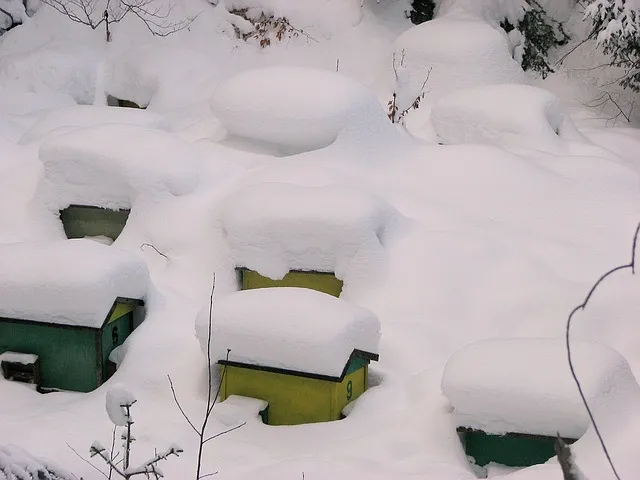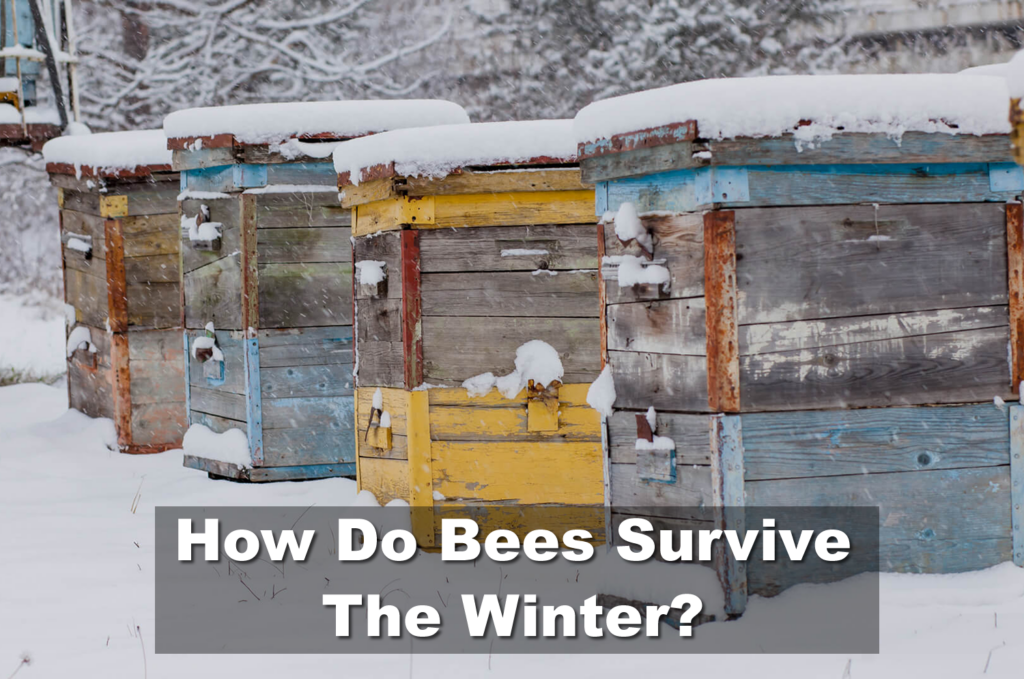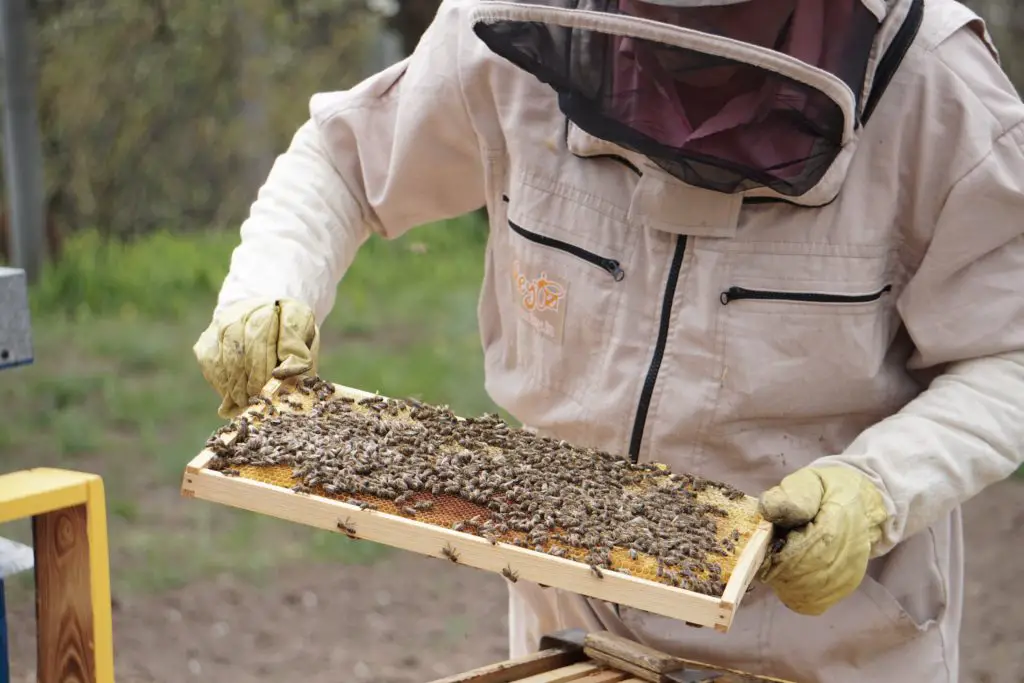Affiliate Disclaimer - As an Amazon Associate I earn from qualifying purchases.
It supports the website. So, Thank you
In summer, we’re all used to seeing bees buzzing around, collecting nectar, making honey, and generally going about their bee business. But when the cold weather comes around, we stop seeing our winged friends because they’re just not equipped to handle the low temperatures. However, we see them again in spring, so how do bees survive the winter?
During winter, honeybees will retreat into their hive and huddle together to keep warm. It is very rare that they’ll leave and usually enter a state of dormancy until the weather improves.
Understanding the behavior of bees during winter and how best to help your hive during those cold months will ensure their survival. In this guide, I’ll discuss what to expect from your bees in winter and how you can ensure that they get through the cold weather.
Table of Contents
What Do Honeybees Do In Winter?
During the winter, the main aim of honeybees is to stay warm and have enough food to survive the entire season. If they don’t have enough food, they won’t have enough energy and therefore won’t be able to keep warm. This is one of the main reasons for hive death over the cold months.
However, bees are very intelligent animals and know that they need ample food supplies over winter. So, during the summer months, they’ll work very hard, gathering enough supplies not only for summer but for the entire winter as well. They’ll gather nectar and make honey which they can feed on when the winter rolls around.
At the end of summer, moving into fall, you’ll notice that the honeybees’ activity starts to die down. It’s at this point that they stop foraging for food because it is now very scarce. Instead, they’ll go into the hive and huddle together to keep warm. At the same time, the queen will stop laying eggs.
The entire hive focuses its attention on the queen who can be found right at the very centre of the cluster. If there are any eggs or larvae, these will also be surrounded by the other bees in order to keep them as warm as possible.
When forming a huddle, the bees will have their heads pointing inwards. Bees that are on the inside are able to feed on the honey that’s been made over the summer while those on the outside keep internal bees nice and toasty.
While all of this happens in fall, the temperature continues to drop and when it reaches around 57ºF, the bees will huddle in even closer, forming a very tight cluster. They’ll combine their body heat and this is more than enough to keep all of the colony warm. But what’s really interesting is that the bees in the cluster will react to slight temperature changes, expanding and contracting the huddle accordingly.

How to Help Your Hive In Winter
Wild honeybees whose nests are not managed by humans manage perfectly well over winter so there’s really no reason that your hive shouldn’t thrive by itself. That said, there are things you can do to increase the chances of survival, especially in young hives where there may not be enough food.
Food
The amount of food that any particular hive needs to get through winter will vary enormously. This will largely depend on things like the size of the colony, the local climate, and how well-insulated the hive is.
It’s always best to leave more honey than you think the bees will need and take just a small amount for yourself. Generally speaking, the bees will need to have between 50 and 90 pounds to keep them going over the winter.
In the best-case scenarios, you won’t need to worry about feeding your bees at all over the winter. However, this doesn’t always apply and you should be vigilant. If you notice that the supplies are low, you may need to offer a sugar water substitute.
You’ll want to use plain white sugar as this is the best option and be mindful not to use anything that contains any additive. If you have honey from another hive, it can be tempting to give this to your bees but this should be avoided at all costs. Using honey from other hives can spread disease and comes with a risk of killing the entire colony.
It’s easy to make sugar syrup, you just need to add one part water to two parts honey. While this isn’t as nutritious as honey, it’ll do the job but you can add in some essential oils if you want to give it a nutrient boost. I’d also advise only using internal feeders as this will save the bees from having to leave the hive and be exposed to the cold.
Predators
During the winter, your hive may be at risk of being attacked by predators such as badgers, deer, green woodpeckers, and mice. Mice are the worst culprits for attacking a bee hive and they can often get inside without even being noticed owing to the fact that the bees are so closely huddled together.
For mice, the inside of the hive is warm, dry, and ideal for sheltering over the cold months. What’s more, there’s even a food supply right there in the hive so mice see it as something of a luxury hotel! While that does sound worrying, the simple installation of a mouse guard means that they won’t be able to get in.
While the green woodpecker can be a threat, they only really pose an issue in the hardest winters. They’ll usually feed from the ground, eating ants but if the ground is frozen, they have to think outside the box; or inside it, as the case may be. They’ll use their beaks to drill through the side of the hive and attack the bees. In order to prevent this, you can use chicken wire around the outside of your hive.
Badgers can be a problem but they’re nowhere near as much of a pest as mice. The problem is that they’re easily able to use their paws to remove a mouse guard so that’ll serve as no protection against these critters. Moreover, badgers have been known to attempt to push the entire hive over but you can stop this by placing something heavy, like a rock, on the top which will make it more difficult to push.
If possible, I’d recommend placing your hive on a slab and securing it with a ratchet strap. It’s going to be nigh on impossible for a badger, or any other small animal, to knock it over.
Weather
One of the biggest threats to the survival of a beehive over winter is the weather. But while a lot of people think that it’s the low temperatures that’ll kill off a colony, it’s actually moisture or dampness.
This is why it’s so important to make sure that your hive is well-ventilated over winter. In fact, it is even more important at this time of year than it would be in the warmer months, which may come as a surprise to most.
You should make sure that there is sufficient ventilation at the bottom of the hive and ensure that no entrance blocks are in place when you install a mouse guard.

What About Other Types Of Bees?
Honeybees are not the only type of bees that adapt their behavior in order to get through those chilly winter months. Let’s take a look at how the bumblebee and solitary bee manages to cope.
Bumblebees
Bumblebees are very different to honey bees in that most of them will die off before winter comes around. The bees will mate during the summer and the fall and it’s at this time that new queens are born. By the fall, any males, worker bees, or queens will die.
If a queen is newly mated, then she will go into hibernation over the winter by burrowing under the ground in places where there are soft spots or by hiding under stones, rocks, and logs. This keeps them out of the frost and wind and you’ll find that they usually opt for north-facing spots so that they aren’t exposed to the winter sun which will warm them too early.
That said, in the UK, it has been observed over the last ten or so years, that some queen bumblebees have stopped hibernating in winter and instead start making a new nest. This is more likely to happen where the winters are milder or in urban areas that have a lot of winter flowering plants.
Solitary Bees
The thing with solitary bees is that no two are the same in terms of lifestyle and behavior. This means that the way they spend their winters is incredibly diverse.
In most cases, adult solitary bees will die before winter and it’s just the eggs that have been left behind by the females. They will seal them in a burrow or a cavity and leave food supplies for when they emerge. These bees are so smart that they will even line the nest with secretions that make it waterproof so there’s no chance of the babies suffering death from damp!
When solitary bees reappear in spring, they will grow to their adult size throughout the summer. There are many species of bees that do this including the ashy and tawny mining bee and the red mason bee.
When winter arrives, young adults will go into a cocoon and enter a dormant sleepy state until spring when they will re-emerge and feed on the new spring flowers.
Some other species of solitary bee such as the yellow-faced bee and the wool carder bee actually spend the winter hibernating in the larval stage. They enter a dormant state which allows them to get through the cold season without the need to feed or exert a lot of energy. When spring comes around, they’ll grow into adults before summer.
What’s interesting is that there have been several winter sightings of solitary bees but this is not natural. This usually occurs when they are disturbed by animals or even humans digging in the ground.
Helping Other Types Of Bees In Your Garden During Winter
Even though beekeepers might not take care of a colony of other bees, there are still things we can do to ensure their survival.
For starters, it’s a good idea to plant winter flowering plants so there is a viable food source for any bees that do emerge early. This can include things like hellebores, heather, snowdrops, and winter honeysuckle.
You should also make sure that you leave the ground alone; any digging can wait until spring. If you dig during the winter then there is a risk that you’ll disturb burrowing solitary bees. Also, make sure that you don’t remove any dead stems as there could be bees inside them.
For people that have a bee hotel, you’ll need to move this to a new location where it’ll be protected from dampness such as a garden shed. Outside, you can create a mini-habitat for the bees which can include logs, rocks, and a bank of earth which is ideal for bumblebees.
Conclusion
If you’ve ever wondered how bees survive the winter, it’s all about staying warm. Honeybees will huddle inside the hive, keeping the queen in the centre to fully protect her. However, other types of bees spend winter in very different ways with some bees dying off before the cold weather even sets in.




